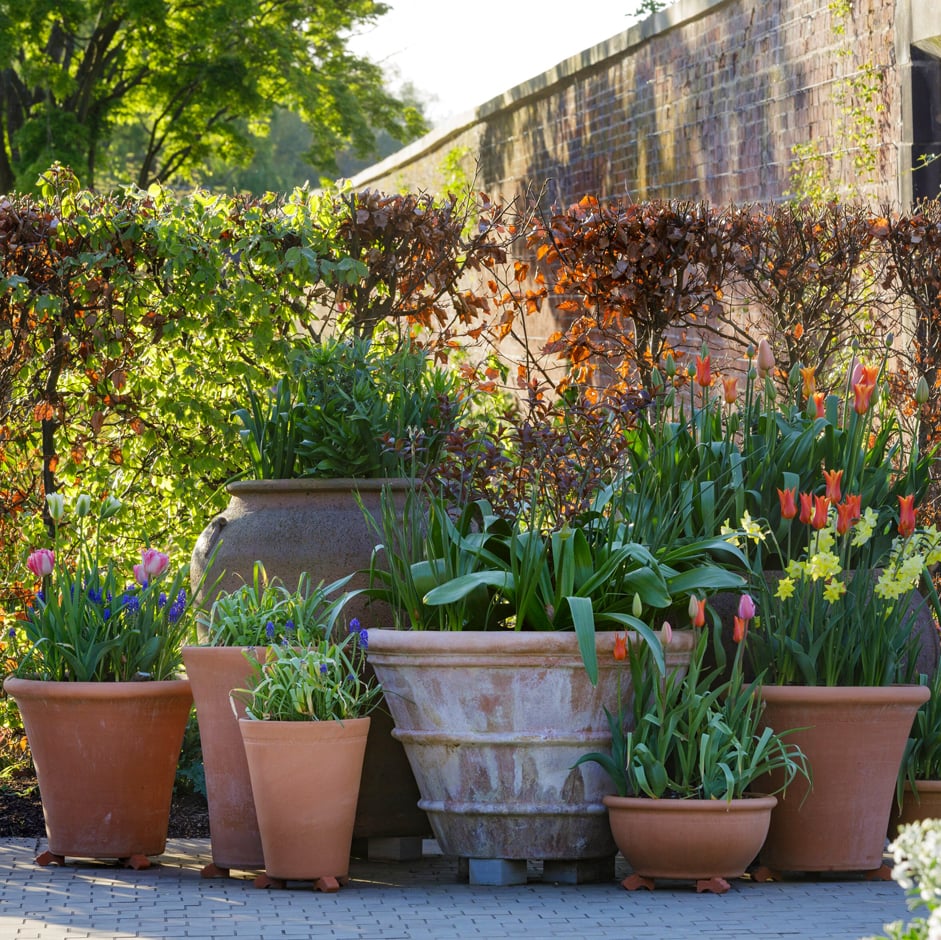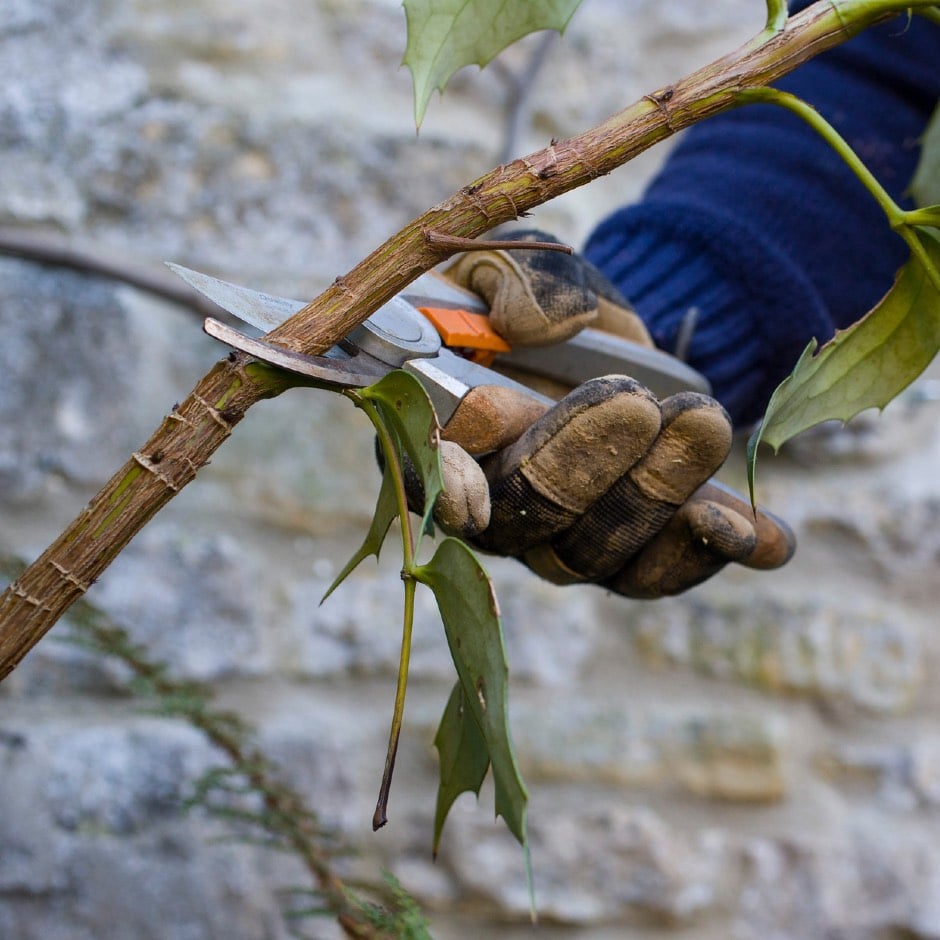Growing guide
How to grow choisya
This popular, easy-to-grow and versatile shrub offers fragrant white flowers in spring and attractive, aromatic leaves that provide year-round structure. Here are our growing tips for your choisya, whether growing in pots or in the ground.
Quick facts
- Sweetly scented white flowers in spring and summer
- Compact, reliable and low maintenance
- Evergreen shrub provides year-round interest
- Thrives in sun or light shade
- Smaller cultivars can be grown in a large container
- Different foliage colour choices
All you need to know
Originating from rocky areas of Mexico and the South West USA, choisyas are a small group of evergreen shrubs that have become a garden favourite. They suit all styles of garden; formal or relaxed, large or small, and a wide range of locations including mixed borders and large containers. They also work well as an informal flowering hedge
With aromatic palmate leaves and white, fragrant flowers, choisyas like a sunny spot, sheltered from cold winds, in soil that is neither too wet nor too dry. Here are some things to think about when deciding on the right choisya for you;
Eventual size
At around 1.5m (5ft) high Choisya × dewitteana ‘White Dazzler’ is the most compact of the choisyas so makes a great plant for a container. Others get to around height and spread of 2.5m (8ft) though all will take a bit of clipping.
See our guide to Choisyas by size

Choisya by size
Shade and shape of foliage
Leaves on choisya may be dark green or golden, so choose a colour you like and which will work well for the spot. Note that golden-leaved forms tend to be more green-yellow in shade. Also decide on leaf shape; some bear slender, narrowed leaflets, while others have broader leaflets, giving an overall fuller look to the shrub.
Top Tip
Evergreen shrubs such as choisya provide shelter for a wide range of wildlife all year round, including valuable nesting sites for birds early in the season.
To browse photos and descriptions of choisyas, go to RHS Find a Plant. Four cultivars have an RHS Award of Garden Merit, which shows they performed well in RHS trials, so are reliable choices.
How and what to buy
Choisyas are widely available for much of the year in garden centres and by mail order online, usually in 2-3 litre containers.
As they are evergreen, you may also find small plants sold as winter bedding in autumn, in 9cm (3½in) or 1 litre pots. These are ideal for adding winter greenery to container displays and are good-value options, as they can be given a permanent home in the garden afterwards, when the winter bedding is replaced.
If purchasing from a garden centre, look for plants with firm, glossy leaves and a bushy rather than straggly shape. Golden-yellow leaves, especially at the tips of the shoots, may be a feature of the plant but if the yellowing leaves are also dull and wilting or there is noticeable leaf drop, avoid such a plant.

Buying: trees and shrubs

RHS guide to choosing healthy plants
When to plant choisya
The best time to plant is in spring or autumn, when the soil is warm and damp, so the roots settle in quickly.
However, choisyas are on sale for most of the year and can be planted at other times, although they may take longer to get established. Avoid planting in extremes of hot or cold weather.
Where to plant choisya
- Choisyas like well-drained soil in full sun or partial shade. Most don’t like a cold spot, and Choisya × dewitteana cultivars in particular (such as ‘Goldfingers’ and ‘Aztec Pearl’) are best grown near a sheltered, sunny wall, for extra protection
- If your soil is prone to waterlogging, grow a small choisya cultivar in a container
- Choisyas work well as stand-alone specimens or mingling with other plants in flower borders and shrub borders. They also make attractive, low-maintenance, informal flowering hedges
- If you position a choisya near a path or patio, it’s easy to enjoy their fragrant flowers

Microclimates: assessing your garden

Grow a flowering hedge
How to plant choisya
Choisyas are easy to plant in borders. If your soil is on the heavy side, add some well-rotted garden compost or manure first to help improve drainage.
If planting permanently in a large container, use a loam-based compost mix – two-thirds John Innes No.3 and one-third peat-free multipurpose compost. Try not to pot up too late in the year as there is a danger the roots will sit in soggy compost over winter. Spring is always the best time to give your choisya a new pot.
For full planting instructions, use our guides below.

Growing plants in containers

Trees and shrubs: planting
Watering
- Water newly-planted choisyas regularly for the first year, until the roots have grown out into the soil
- Established plants in borders shouldn’t need watering, except in hot, dry summers
- Choisyas in containers need watering regularly, but take care not to let them sit in damp compost for long periods, especially in winter

Water: collecting, storing and re-using
Feeding
- When growing in fertile soil, choisyas shouldn’t need feeding, although an annual mulch of well-rotted compost is beneficial
- On poor soil or to give plants a boost, you can add a general-purpose fertiliser in spring, such as Growmore or fish, blood and bone
- If flowering is poor, apply a potassium-rich feed, such as Vitax Q4 or sulphate of potash in spring
-
Top-dress container choisyas in early spring by removing the top 5cm (2in) of compost and replacing with fresh compost. Mix in a controlled-release feed too. See our guide to container maintenance

How to feed plants
Mulching
- Apply a thick layer of mulch around choisyas in borders every spring to help retain moisture around the roots through the summer months
- Home-made compost is ideal
- Leave a gap around the base of the plant to avoid rotting the stem
Why add mulch?
An organic mulch, such as home-made compost, is a great way to add nutrients and valuable micro-organisms to your soil. It also holds in moisture and deters weed germination.
Overwintering
- Most choisyas are hardy, but prefer a warm, sheltered spot, out of cold winds
- When growing in containers, plants are more vulnerable to cold around the roots, so are best moved to a sheltered location over winter, such as a porch or in the lee of a wall. Don't let the compost get waterlogged
Once established, choisyas don’t generally need pruning. But if they are growing poorly or getting too large, you can prune as follows:
- If growth is spindly, prune back by up to a third – see our guide below
- If an established plant gets too large, you can prune it back hard in spring – choisyas generally regenerate well. See our guide below
- The best time to prune choisyas is before growth starts in mid-spring (April), once there is no longer any risk of frost. But if your plant is flowering or about to flower in mid-spring, you can delay pruning until flowering has finished
- Choisyas are pruned as for other early flowering evergreens in RHS pruning group 8 – see our guide below
- Deadheading can be carried out after the flowers have finished, cutting back to a healthy leaf bud below the spent flower head

Shrubs: renovation

Shrubs: pruning evergreens
Top Tip
Before pruning in spring, always check shrubs and hedges carefully, and delay if you find an active nest.
Choisyas can be propagated by taking semi-ripe cuttings from late summer to mid-autumn. Select new shoots that have a firm base and soft tip.
Cuttings: semi-ripe
Choisyas are generally trouble-free when grown in a warm, sheltered spot, but they can occasionally suffer from the following:
- dieback of stems – may be caused by frost damage. Prune out affected areas in spring and if the plant is growing in a container, move it to a more sheltered spot over winter
- scale insects
- red spider mites
- snails
- verticillium wilt
Managing pests and diseases without chemicals
Preventing pest and disease problems
Additional help
If you're a member of the RHS, you can use our online Gardening Advice Service, via MyRHS, for any gardening problems or queries.

Discover choisya
Everything you need to know about choosing the right choisya for you.
Get involved
The Royal Horticultural Society is the UK’s leading gardening charity. We aim to enrich everyone’s life through plants, and make the UK a greener and more beautiful place.